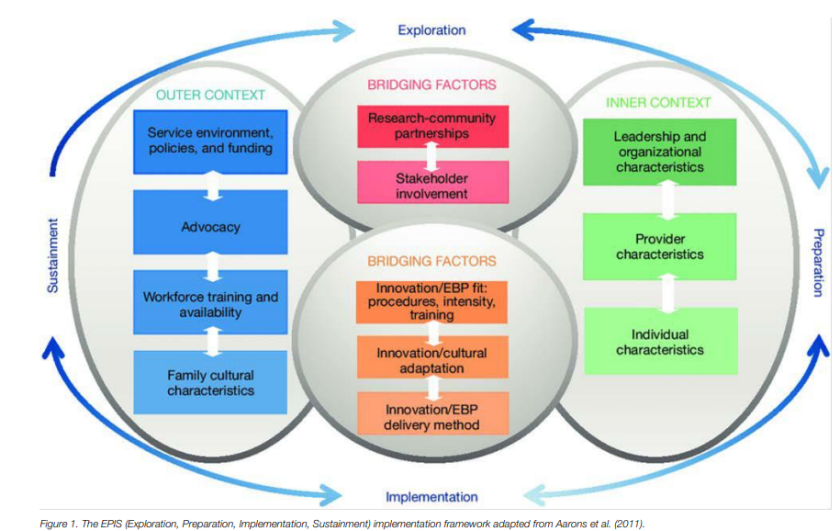CEI Senior Advisor Dr Karla Lopez published in the ANZ SEBP - Australia and New Zealand Society of Evidence Based Policing Police Science journal Policing Insight on maximising the chances of implementing evidence-based policing strategies successfully.
This article first appeared in the Winter 2021 issue of Policing Insight.
Beyond the evidence: insights into the role of implementation science from a decade in policing
Implementation science is the study of methods to promote the systematic uptake of research findings and other evidence-based practices into routine operations (Bauer, Damschroder, Hagedorn, Smith & Kilbourne, 2015). In other words, implementation science is the study of how to close the evidence-practice gap. The merit in using research evidence to address operational policing challenges is irrefutable to anyone involved in the endeavour of evidence-based policing.
We strive to use data-driven insights, synthesise the evidence and device meaningful interventions that represent an improvement on previous practice. In the context of increasing scrutiny, shrinking budgets and stretched resources, it is more important than ever to ensure that evidence-based practice (EBP) remains in place with reasonable fidelity after we walk away. How do we ensure that happens?
During my decade driving evidence-based practice in a policing context, I worked tirelessly to generate research evidence, train police and develop novel evidence-based solutions for operational policing problems. But only now, after learning about implementation science, have I developed a greater awareness of practical implementation activities, which can be applied immediately to embed EBPs in policing organisations.
A large number of implementation frameworks available in the implementation science literature outline the processes and practical strategies that have the potential to support the work of capability uplift within policing services. By making explicit the phases involved in successful implementation, these frameworks enable EBPs not only to be appropriately introduced but also ultimately sustained. An effective evidence-based practice is necessary, but not sufficient, and implementation science brings the missing piece. In order to get to outcomes, and sustain them, it is not sufficient to just focus on the ‘what’ (the EBP) we also need to focus on the ‘how’ (implementation process).
An established example of a useful implementation framework outlines four implementation phases, namely Exploration, Preparation, Implementation and Sustainment (EPIS) (Aarons, Hurlburt & McCue Horwitz, 2011). It also identifies factors most likely to have an influence on the implementation of EBPs in publicly funded settings (Figure 1, below).
In the Exploration phase, a service system or organisation, such as a policing agency considers emergent or existing needs of stakeholders or the community, identifies the best EBP to address them and decides whether to adopt it. Societies of Evidence Based Policing across the world play an important role in examining and generating EBPs but can face challenges at the implementation level when attempting to influence key decision makers. However, during this exploration phase, an opportunity exists not only to provide the EBP but to outline the necessary adaptations to the system, organisation or the EBP itself to optimise its successful adoption and associated impact. This stage also explicitly calls for engaging stakeholders and understanding their needs, which can really lay the groundwork for successful implementation.
During the Preparation phase, the key objective is to identify potential barriers and enablers of the implementation in the specific (internal and external) context, define whether any adaptation is required to the EBP and to develop a detailed implementation plan. The plan clearly identifies key implementation supports and how they will be rolled out. Therefore, it typically includes training, coaching as well as audit and feedback plans and carefully considers how an implementation climate will be developed which will signal that use of the EBP is expected, supported, and will be rewarded within the organisation. In a policing organisation, these plans will likely clarify the cohort to be targeted for training, how they will be supported to adopt the EBP (coaching) and how this aligns with organisational imperatives, relating to evidence-based policing, intelligence led interventions, community partnerships, demonstrating public value, etc.
Moreover, this phase establishes the internal implementation team who will take responsibility for the implementation of the EBP. They will do this my monitoring and working through implementation barriers and enablers, and identifying relevant implementation strategies that will overcome the barriers being experienced. The implementation team needs to be well positioned to navigate and influence the implementation context and must be able and willing to champion the EBP.
In the implementation phase, targeted and planned supports for implementation of the EBP are actioned in accordance with the plan from the Preparation phase. A key focus of this phase must be to monitor, review and respond to data that provides insights into implementation quality and EBP effectiveness. That is, the plan must mobilise data collection efforts and analysis which elucidate whether the EBP has been adopted, whether it is reaching the intended target population, whether it is being used as intended (fidelity), and whether it is having the intended effect. These insights must in turn be used to inform data-driven decision-making about adapting the implementation plan as required to improve the process and desired outcomes. It is crucial that ongoing monitoring of the implementation process is incorporated into this phase to assess how it is proceeding and to support efforts to adjust accordingly (EPISFramework.com).
Reaching the sustainment phase means that the inner and outer context structures and supports are well positioned to ensure that the EBP continues to be delivered in a manner which enables the desired impact/ improvement on policing practice over a sustained period of time. This means that in the context of dynamic and responsive policing, shifting leadership and priorities, implementation leads must ensure that plans, processes, EBPs and their impact are recorded and appropriately captured to continue. It means that personnel changes on account of promotion, surge response, etc. do not result in an absence of champions and local implementation drivers for the EBP. Considering and planning for sustainment should be part of all phases to guard against major set-backs, and to maximise forward momentum.
It is important to note that at each phase, there are a range of contextual factors that must be taken into account and addressed in the implementation plan, and these will feature to differing extents in each phase. At the exploration phase for instance, outer context factors relating to legislative changes, funding or community opinions may be key considerations. However, at the planning phase, the focus may shift more to internal contextual factors relating to leadership support, organisational characteristics (e.g. tolerance for innovation) and staff skill-sets. Also during the preparation and implementation phases, the role of partnerships and intermediaries (i.e. implementation specialists) is arguably most important as the organisation prepares the context, individuals and execution of the implementation plan and establishes its collection and future use of data to embed the EBP. Conversely, the characteristics of the intervention in terms of suitability, adaptability and acceptability in the implementation context are relevant throughout the entire implementation process.
Beyond the evidence and internal executive sponsorship, there are practical ways to maximise the impact of EBPs by being intentional about how they are implemented. From preventing bushfires to counter-terrorism watchlists, from hot-spot policing to targeting recidivist offenders, implementation science maximises the opportunities for interventions to have the desired impact and enables an understanding of the specific conditions under which they work. Emerging evidence from scientific or field trials has the best opportunity to lead to sustained change and continuous improvement in policing practice under its optimal implementation conditions. It is clear that once an innovation or intervention has been shown to work in the policing context, it is necessary to methodically and deliberately plan its broader operational execution and implementation frameworks can provide a roadmap to meaningfully guide this process.
Figure 1. The EPIS (Exploration, Preparation, Implementation, Sustainment) implementation framework adapted from Aarons et al. (2011).

References
Aarons, G.A., Hurlburt, M. & Horwitz, S.M. (2011). Advancing a Conceptual Model of Evidence-Based Practice Implementation in Public Service Sectors. Administration Policy Mental Health 38, 4–23.
Bauer, M.S., Damschroder, Hagedorn L.H., Smith, J. and Kilbourne, A.M. (2015). An introduction to implementation science for the non-specialist. BMC Psychology, 3(1), 32.
Carroll, C., Patterson, M., Wood, S., Booth, A., Rick, J. & Balain, S. (2007). A conceptual framework for implementation fidelity. Implementation Science, 2, 40.
